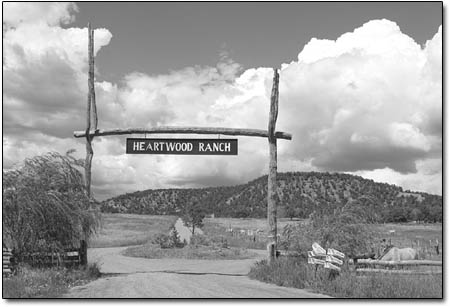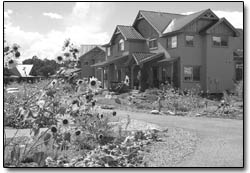 |
| Afternoon clouds roll past
the entrance to Heartwood Ranch recently. The Bayfield co-housing
subdivision is based on a Danish concept that focuses on
retaining open space and creating a small-scale neighborhood
where the placement and style of houses foster interaction
and cooperation among residents./Photo by Todd Newcomer. |
At Heartwood Cohousing, a private subdivision in Bayfield,
residents have turned the clock back 50 years to a time when
neighbors shared much more than property lines and speedy glances.
It used to be that subdivisions were actually designed with
neighbors in mind. Houses had front porches where residents
gathered, garages were built behind and unattached to houses,
residents actually saw each other come and go.
However, in the past 20 years, subdivisions have taken a turn
toward privacy. Garages face streets, protruding in front of
houses. Six-foot fences block any kind of interaction. And sometimes
the nearest neighbor is several acres away. Suddenly, people
are living in a disjointed community.
But residents of Heartwood Cohousing eschew such living arrangements,
which is why they have built a housing project that drastically
transforms the definition of community. Heartwood requires that
all houses have front porches. Homeowners don’t have fences
cordoning themselves off from their neighbors. There are no
garages either. And cars – not the central theme in this
community – are relegated to the periphery of the cluster
of houses, obligating everyone to walk along the common pathway
to get home.
Here, residents are creating a kind of micro-society that relishes
steady interaction, cooperation and collective living. To some,
iat appears to be a radical style of existence yet it only seems
radical in the context of recognizing how subdivisions are built
today, residents say. Actually, this style of living is about
as traditional as you can get.
“This isn’t some new wave of a living style,”
says Johann Robbins, a Heartwood resident of 2 BD years. “This
is closer to how we are wired to live versus having a garage
in front and using cars all the time.”
Danish movement
The cohousing idea began in the early 1970s in Denmark, when
dual-income professionals wanted better day care and safer neighborhoods.
Twenty-seven families in Copenhagen turned to cluster housing
and a pedestrian-friendly development style that fostered relationships
with neighbors.
In the late 1980s, the cohousing concept gained recognition
in the United States, and the first cohousing project in the
country was built in 1991. But only in recent years has it begun
to gain popularity.
According to the Cohousing Association of the United States,
there are 66 completed cohousing projects in this country –
a 12 percent average annual growth rate during the past five
years. The group reports that there are 19 neighborhoods under
construction and an estimated 150 cohousing groups in various
stages of the development process.
Colorado ranks third among the states with completed neighborhoods
(nine) and has three other active projects. When Heartwood Co-housing
completed its development in the winter of 2000, it became the
first cohousing project in the Four Corners. The nearest cohousing
project is in Santa Fe, N.M.
Typically, cohousing projects are designed and built by residents,
who work on a grassroots basis from beginning to end. The core
group secures financing – either public or private –
to purchase land and start construction. Residents decide on
all aspects of the development, including design, business structure,
policies and procedures. However, as cohousing has gained recognition,
some developers have created companies that do all of the cohousing
design and development.
Interaction and cooperation
Because Heartwood is the first cohousing project developed
in La Plata County, residents met some initial resistance from
the county government. Robbins says county leaders were reluctant
to allow a cluster of houses on a small tract of vast acreage.
Heartwood owns 350 acres, but the development, which consists
of 22 completed homes (all single family except for one duplex)
and two in progress, is confined to only 7 acres. It’s
not an affordable housing development, and home prices and values
at Heartwood range from between $220,000 to more than $400,000.
Restricting the amount of land used for housing was necessary
to accomplish the goals of cohousing, Robbins says. Those goals
are to retain open space and create a small-scale neighborhood
where the placement and style of houses foster interaction and
cooperation among residents.
The asphalt pathway weaves throughout the cluster, connecting
each home to others as well as a playground and outlying buildings.
Houses – all uniquely designed with adobe and solar power
– are well kept with an organic look and carefully xeriscaped
yards. The focal point of the development is the Common House.
Psychic energy
Upon entering Heartwood, the Common House is the first thing
residents and visitors encounter. It’s a large 3,700-foot
building where residents meet for anything public – meals,
meetings, recreation, parties and socializing. Besides an abstract
walkway, the Common House is what unifies the more than 40 residents
who make Heartwood their home.
On a recent Friday evening, a couple dozen children and adults
meet at the Common House for their weekly potluck. Before sitting
down to dinner, the adults hold hands while encircling the kitchen
island. This week, they are “christening” a newly
built wooden island where they can prepare food for the potluck
and the twice-weekly community dinners, which residents take
turns cooking.
 |
| Sunflowers brighten the walkways
through the Heartwood Ranch subdivision. Built in 2000,
the cohousing neighborhood covers 7 acres and consists of
22 homes, with two more under construction./Photo by Todd
Newcomer. |
Keeping in the spirit of remembering the various ethnicities
and practices among the group, the adults don’t engage
in any kind of religious offering or blessing. Instead, they
praise the woodwork of the residents who built the island. And
they dictate the rules for using it – not to be heavy-handed
but to respect different cultures by keeping the island kosher.
During dinner, Michael and Beth Walker, who were involved with
Heartwood from its inception, explain why they decided to move
out of their Durango neighborhood and join this cohousing community.
Michael Walker says that the family yearned for a sense of
community and cooperation that was impossible to find in most
neighborhoods. They wanted a place where they and their children
felt safe, where neighbors cooperated and where they had a social
group with whom they shared common characteristics.
Even though they sought this type of association, the Walkers
wondered if cohousing would work for them – as well as
the others.
“It takes a lot of money and psychic energy to get something
like this built,” Michael Walker says. “And it calls
for a lot of heart to keep it together.”
Beth Walker says the concept works at Heartwood because residents
are loyal to the idea of living in unity.
“When you move into someplace like this, it’s no
longer ‘I,’ it’s ‘we,’”
says Beth Walker. “This type of community is a different
way of thinking.
Fran Hart, who actually lived in a trailer on the land before
the project began, agrees.
“I thought to myself, if Native Americans can live with
six generations in a Hogan, I can learn how to live next to
my neighbors,” she says.
Hart says she chose to live in a cohousing development because
“it’s lined up” with the values in her life
– notably clustered housing and open space.
Modeling maturity
Besides creating a sense of community within the larger society,
residents believe this style of living is a good role model
for children. The Walkers say their two children know how to
co-exist with others in a more cooperative way, using consensus
and communication as tools to ensure peace.
“Our children have blossomed in a thousand ways since
moving here,” Beth Walker says. “They are growing
up learning that they have to consider other people.”
Since cohousing’s foundation is built on consensus, harmony
and volunteerism, living in this type of environment teaches
many more lessons than how to run a neighborhood, residents
say. Ultimately, each person gains insight and knowledge that
run the gamut of life – from carpentry skills to interpersonal
communication. For that, they say, there is no equivalent in
most neighborhoods.
“I think that this is the longest, most valuable personal
growth experience you can have – at least that’s
what it’s been for me,” says Michael Walker.

